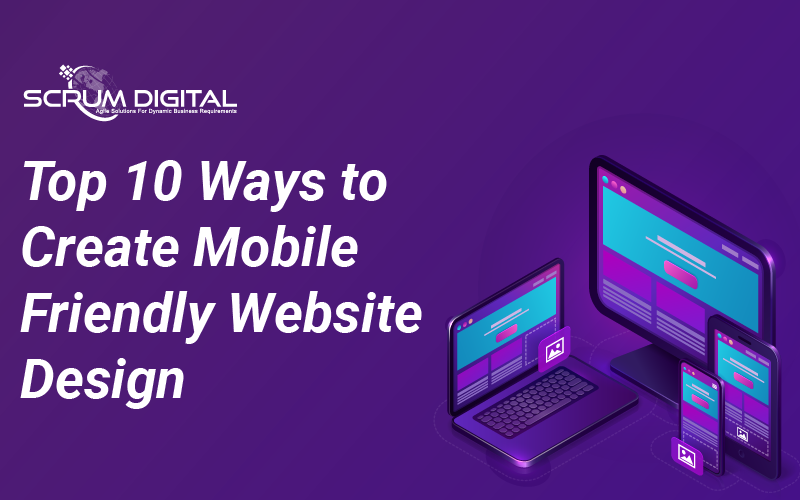Here’s a mind-boggling statistic about mobile—there are almost 5 billion mobile internet users worldwide, and the numbers are increasing yearly. They account for over half of all internet traffic! So, what does this mean for your business? For starters, most of your customers are not browsing on desktops anymore.
To stay ahead, your business needs to prioritize responsive web design that adapts seamlessly to different screen sizes. This means creating a mobile-friendly website design that ensures a smooth and engaging experience for users, whether they’re scrolling on their smartphones, tablets, or laptops.
Ignoring mobile users in your web design strategy could mean missing out on a significant portion of potential customers, so investing in a responsive, mobile-friendly approach is more critical than ever for growing your digital presence.
Why Make My Website Fit on All Devices?
With more internet traffic coming from mobile users, Google has shifted its focus toward mobile-friendly website optimization. Failing to have a mobile-friendly website design can ruin your other organic search efforts. You need to make website mobile-friendly and optimize it to increase or maintain your SERP ranking.
Load time, design and mobile-friendly web design, and optimized content play an important role to boost your rank. However, an optimized website that fits all mobile devices can correspond well with your larger digital marketing strategy.
Traits of a Mobile-Friendly Website

There are many different ways one can optimize a website and make it more mobile-friendly.
Here are a few features that are often seen in websites that are optimized keeping in mind a mobile-first approach.
- Sites are faster to load
- Websites have limited and precise information
- There are fewer moving parts
- Pop-ups are limited and used only when necessary
- Menus are simplified
- Contact information is featured prominently
- Buttons are large and can be easily accessed
- Call-to-action information is noticeable
5 Key Benefits of a Mobile-Friendly Website
Having a mobile-friendly website comes with a plethora of benefits. Desktops are becoming less used and smartphones are the preferred way of connectivity now. This use of smartphone usage can be leveraged by businesses by creating a website with a mobile-first approach and not letting the mobile traffic dwindle. In simpler terms, you need a mobile-friendly website because that is where the future of web designing is headed.
1. With most of the web traffic nowadays coming from mobile devices, the next generation of consumers will want to have access to your business from mobile devices as compared to traditional desktops or laptops. Their first introduction to your business will likely be through a mobile device. So making a good first impression through a robust mobile responsive website is crucial.
2. Mobile consumers are the big buyers of your products and services, Mobile phone users usually use their phones to do shopping, look for sales, coupons, quick reviews or research about products. Businesses can leverage this by optimising their website with a mobile-first approach.
3. Google usually favors to rank and list websites that are mobile responsive. Having a mobile-friendly website can mean easier ranking for your website on google.
4. One of the great things about mobiles is that they are easy to share information with. Be it pictures, videos or articles with your friends and family. Mobile-friendly sites have social media buttons for easy sharing.
5. Beyond the absolute convenience that mobile devices are another reason they are popular to browse is there is less advertising on mobile web pages. A mobile optimized website usually provides users with an experience that minimizes display ads.
How to Make the Existing Website Mobile-Friendly?

There are some basic steps you can take to complete that yourself. How do I make my website responsive? According to Google here are some ways you can use to improve the site’s responsiveness and user experience on mobile devices.
1. Start with a Mobile-First Approach
This practice of design and development for mobile first then desktop can be a game-changer. While some developers design and develop for desktop first and then scale down to mobile can be counterproductive if your main focus is on mobile-friendly website design. With mobile-first indexing, reversing the process can help you optimize the mobile design from the start.
2. Use a Responsive Web Design
A responsive web design is a simple and convenient way to create a mobile-friendly website or leverage an existing one. Installing a responsive theme will automatically make your website adaptable to any device.
A responsible website layout also boosts the SEO value of your website, and Google prefers to rank and index websites that are mobile-friendly.
3. Pay Attention to the Site’s Appearance
While the content is the primary reason people are drawn to a website, the design drastically impacts your site’s bounce rate. Therefore, it’s important to create a good impression from the beginning. Use Google’s mobile-friendly test tool to check how mobile-friendly website design is.
4. Enable Accelerated Mobile Pages

The Accelerated Mobile Pages (AMP) is a framework that focuses on speeding the load time of your mobile site by restricting HTML/CSS/ Javascript and compressing data by eight times. This results in a 4x faster loading process.
AMP frameworks benefit by-
- Accelerating site loading time on mobile devices.
- It improves server performance by using Google AMP cache.
5. Optimize Button Placement
On mobile-friendly website design, you should make them easy to spot. They should be large enough to be tapped through fingers and placed strategically. With most mobile users using one hand CTA button should be placed conveniently for one-hand usage.
6. Limit the Number of Pop-Ups

While Pop-ups help in conversions and are easier to use on desktops. Displaying them on the mobile site can be annoying to the visitors. Too many pop-ups create an unpleasant user experience and may force them to leave the website.
It’s best that you disable the pop-ups on the mobile website but if you need to use them, make sure to use them strategically. You should know that Google penalizes websites with intrusive pop-ups. It may lead to poor ranking in SERPs and reduce organic traffic.
7. Use the Viewport Meta Tag
Viewport being the visible area of the webpage is easier to control its scale to show up on different devices that fit properly. This Meta tag allows browsers to fit your web page’s width to any screen that a user uses to access its site.
Insert the following code snippet to apply to the <heads> tags of your website HTML page.
<meta name= “viewport” content=”width=device-width, initial-scale=1’>
8. Give Links Enough Space
Mobile websites have small screens compared to desktops, It is important to have links at appropriate distances so that visitors won’t accidentally click on a different URL.
Tip- Make sure to link webpages that mobile friendly for a seamless user experience.
9. Don’t Use Flash
In December 2020, Adobe stopped Flash’s development meaning none of the major browsers such as Google Chrome, Firefox and Safari support it anymore.
10. Improve Loading Time for your Site

Improving site speed can help lower bounce rates and improve user experience. Test your website’s core web vitals to get an accurate idea of its loading time.
Here are some suggestions to improve the loading site-
A. Compress Image
Page weight, called the ‘gravity of the web’ lowers your app performance by increasing load time and decreasing network data usage. Use compression apps to reduce image size.
B. Implement Caching
Caching helps save website files in a more convenient location, so as to avoid downloading a webpage every time it’s accessed.
C. Using a Content Delivery Network
CDN helps you store web files on multiple servers spread geographically instead of one central server. This helps with balanced loading times regardless of the user’s location while reducing bandwidth usage.
D. Minify your Code
Optimising the CSS, HTML, and JavaScript code of your site can make it more efficient and improve loading time by seconds.
Are you all set to create a mobile-friendly website or optimize the current website with a mobile-first approach?
If you’re looking for professionals to guide you through the journey of creating a mobile-friendly website, Scrum Digital is the perfect IT partner for you.
As a trusted web design company, we combine creativity and technical expertise to deliver websites that not only look stunning but also provide an intuitive user experience. With a team of the best web designers in the industry.
We ensure your website reflects your brand’s essence while staying optimized for performance and responsiveness. Whether you’re building a new website or revamping an existing one, Scrum Digital is here to transform your vision into reality with exceptional design and seamless functionality.


